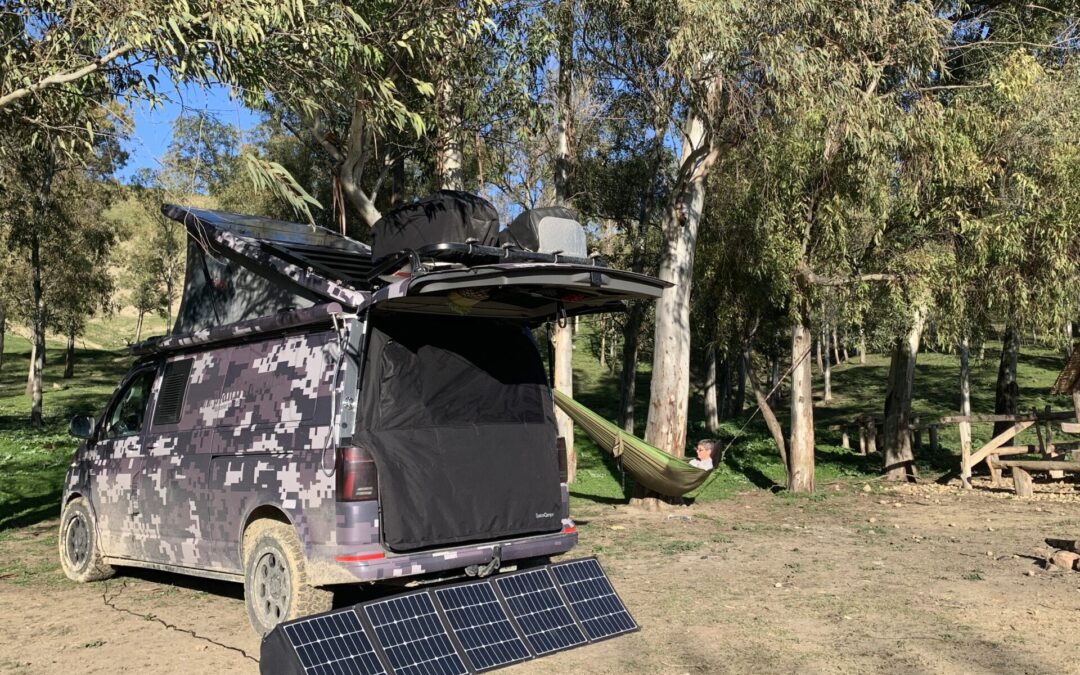Energy and water are among the most important issues on the road. For many travelers in a van, camper van, motorhome or caravan, connecting to shore power on a pitch or campsite is the norm. For this reason, many VW California vehicles have a socket for the camping plug that is visible from the outside.
Shore power
A 3-pin CEE plug with extension cable can then be connected directly to the socket available on the campsite, the so-called shore power. This allows you to conveniently use all 230 volt appliances in the motorhome and also run the refrigerator on electricity.
However, the cable must be long enough and the plug must fit. This is relatively normal on German campsites. But not so much in other European countries. Extension cables and adapters are quickly needed. In Brittany, we once even managed to stand 75 meters away from the power connection. With the Cali, the angled plug with 230 V socket has proved particularly useful. This means you have a second power connection outside immediately and the cable is not so far away from the vehicle. Of course, CEE cables can also be used as extensions. However, many campsites still use the classic 230 V socket. That's why we recommend a high-quality Schuko extension cable for outdoor use. The colored version has the advantage that you are less likely to trip over it. Twenty meters usually even fit on top of the starter battery. We also have an adapter set for Southern Europe, Switzerland and England in our storage box, as well as a 30 meter CEE extension cable. In combination, this should cover 95 % of all places.
SpaceCamper power connection
Our SpaceCamper can also be connected to shore power if required. The external power connection is discreetly hidden under the hood. This allows both the starter battery and the on-board batteries to be charged and the internal 230-volt mains for technical devices to be powered.
Wild & Free
For all those who, like us, want to be wild and free, water and energy are the most important issues. Who wouldn't want to be independent of shore power? Nothing is worse than having to leave your dream spot because you run out of power or water. We have already written something about both topics here: Water and Energy.
Consumers
As a rule, you only really realize how important electricity is when you are not connected to shore power. Then electricity becomes ubiquitous: heating with electricity, cooling with electricity, charging with electricity, lighting with electricity. Maybe even cooking with electricity. We weren't even aware of the issue of heating, for example. After all, we have an auxiliary air and water heater. It runs on diesel. It does, but it also needs electricity.
Cooling doesn't mean the bus, but our cool boxes. These draw a lot of power. Lighting is also a matter of comfort, so you don't always want to look at consumption. We have made sure that everything runs on LEDs. And if you look at our packing list Energy | Electronics | Light | Communication, you can see what we charge. (Coming in the next few days 😉 )
Generate energy
Solar energy is the solution. We generate energy with 2 super-flat solar panels, also known as PV or photovoltaics. These are installed on our SCA roof. They were installed directly by SpaceCamper. The advantage of this solution is that as soon as we set up the roof, the angle is optimized compared to flat systems. This is particularly important in winter when the sun is low.
Motorhome solar system
These two solar modules essentially correspond to the Offgridtec® MobileBlack 200W Motorhome solar system. However, last year's technology, particularly in the area of solar and storage, can almost be considered to be from the Stone Age. In addition, we believe that you can never have enough electricity on board. There are always customers. That's how nice contacts are made. "Your battery is flat? Shall I put an extension cable over for you?" 😉
That's why we would already be installing the next largest module today. This would currently be the Offgridtec® MobileBlack 310W Motorhome solar system.
Solar bag | Foldable solar modules
We have deliberately added a foldable solar module (also known as a solar bag) to the solar system on the roof. This is the slimmer, lighter and more flexible version of the solar case. While the solar case quickly reaches a weight of almost 15 kilograms, the solar bag only weighs around ⅓ of that. The dimensions of (LxWxH) 56 x 44 x 80 cm are also impressive. Because storage space is only available once in the camper. We even transported the solar bag once as hand luggage on the plane from Germany to Portugal. That's how small it is.
You would think that the two panels on the roof generate enough electricity. This is usually the case. Nevertheless, there are several reasons for a solar bag: Firstly, we are self-confessed shade parkers. Secondly, we like to park "the wrong way" so that the solar panels are facing away from the sun when the roof is up. A view of the sea, the mountains or the cow meadow is worth it. The direction of flight also sometimes plays a role. Thirdly, you should bear in mind that the sun is lower in winter.
Then, at the latest, the mobile solar module is perfect. Quickly attached to the van or a tree, it provides us with a wonderful supply of electricity. This is the Offgridtec FSP-2 Ultra KIT 200W. Now some people might ask themselves, why still have solar on the roof? It's just as simple, because it's always charging, even when you're driving. And you wouldn't want to hang up your solar bag outside the supermarket, would you?
Victron charge controller
The power is fed in directly via a Victron MPPT Smartsolar 75/15 controlled. An extremely fast MPPT controller significantly improves the energy yield, especially when the sky is overcast and the light intensity is constantly changing. Compared to PWM charge controllers by up to 30% and compared to slower MPPT controllers by up to 10%. Please note: This controller is already included in the package price of the solar bag.
Our charge controller has a programmable battery charging algorithm. It is then easily monitored via a Bluetooth connection to our smartphone or yours. But be careful! Renewable energy and a solar app are addictive and turn you into an eco-maniac during the day.
Lithium ion batteries
Energy is not only needed during the day and when the sun is shining. We therefore store energy in 2 lithium-ion batteries in addition to the vehicle battery RELiON Rb100 D. The "D" means that the battery fits into the DIN housing commonly used in Germany. This means that it also fits under the seat of a VW bus. Regardless of whether it is a Transporter, Caravelle or California, and regardless of whether it is a driver or passenger seat.
The RELION Rn100 D is a lithium iron phosphate battery/rechargeable battery (LiFePO4). Often also described as a rechargeable deep cycle battery.
If, like us, you want to be self-sufficient for longer, you should definitely treat yourself to a 3rd battery and not save money at the wrong end. Lithium should be your first choice, otherwise you'll be annoyed later. It may seem more expensive at first glance. However, if you consider the following arguments, the lithium-ion battery should not only be the cheaper, but also more relaxed option. As the lithium-ion battery is maintenance-free and has an extremely long service life, this makes it a worthwhile investment and an intelligent long-term solution.
These batteries can confidently be described as a small power station for campers, vans, motorhomes or caravans.
RELiON Lithium Ion rechargeable battery
Advantages of lithium-ion batteries over lead batteries:
- Only approx. 1/3 of the weight of conventional lead batteries
- Up to 10 x longer service life thanks to higher discharge depth
- Very low self-discharge during prolonged storage in winter
- Existing battery can be replaced 1 to 1
- High charging currents and therefore fast charging possible
- High efficiency during discharge
Inverter
We also had an inverter installed by SpaceCamper. This is the above EDECOA inverter with 2500 watts. This converts the input voltage of 12V (direct current) into an output voltage of 230V (alternating current). Devices with a maximum output of 2500W can therefore be connected to this inverter. The maximum power of 5000W is also specified on the device. However, this only serves to absorb consumption peaks that some appliances have at the time of connection.
SpaceCamper | Votronic
SpaceCamper itself installs VOTRONIC components. These include the Votronic Solar charge controller MPP 250 "MPP" stands for (Maximum Power Point).
SpaceCamper has installed a VOTRONIC LCD Solar Computer S so that we can see how much energy our solar system on the roof is supplying, whether the solar modules are shaded or dirty or whether something is wrong.
Note: Our packing list contains our personal product recommendations with so-called affiliate links. Don't worry: Nothing will change for you. The products will not become more expensive. If you buy something through one of these links, we get a small commission. It doesn't matter if you buy exactly the linked item or something else. In 2020, we have earned € 29.87 😉 Maybe we will still be rich. Since we live on our savings, you support our planBwagen and we can take you even longer on the road. Thanks a million!


Good evening
I've been following you on instragram for a few months now. Super cool!
I am getting my new VW t6.1 Beach in January and would like to install a solar system on the roof. Have you built and installed the system yourself? Do you have any tips? I would be very interested in the electrical connection to the van 🙂
Thank you very much and I look forward to your answer
Kind regards
Eros
Sorry, your question was lost. We purchased the solar system directly from SpaceCamper.
Small correction. The blue CEE plugs and sockets are 3-pole, i.e. single-phase. The red CEE plugs and sockets are 5-pole, i.e. three-phase (also known as three-phase / power current).
Campers, vans etc. have a single-phase blue connection.
Hello Markus,
Thank you for correcting my garbage. You're absolutely right, of course.
I changed this immediately. I look forward to further tips of this kind.
How big are your batteries, we have 2X100W lithium ion batteries under the seats (just about fit in lying down). have always been enough so far
Hi Joe,
What does horizontal mean? Ours also have 100W lithium each. As they are DIN housings, they correspond exactly to the camping battery of a Cali and can also be installed upright.
Hello Marc, a question about the batteries in your camper. batteries: How do you view the possible risk of fire when using lithium-ion batteries? I would like to convert and replace the factory-fitted AGM lead batteries with more powerful units ...
Thank you very much for your reply and best regards.
St. Bernard
Hello Bernhard,
small. We are in a SpaceCamper Owners WhatsApp group. We talk about everything there, including the subject of batteries. The only negative thing I hear there is about the starter battery. That's where we've been hit too. It has just been replaced. As soon as the warranty expires, we'll get a stronger one. This is what the net says: "LiFePO4 batteries are currently the best battery technology on the market, with the most advantages. In the so-called nail test or simulated short circuit with temperatures of over 700°C, LiFePO4 cells were tested in the laboratory. The result was that they neither burned nor reached critical temperatures."
Good. Thanks for the quick reply ... I will think about the conversion ...